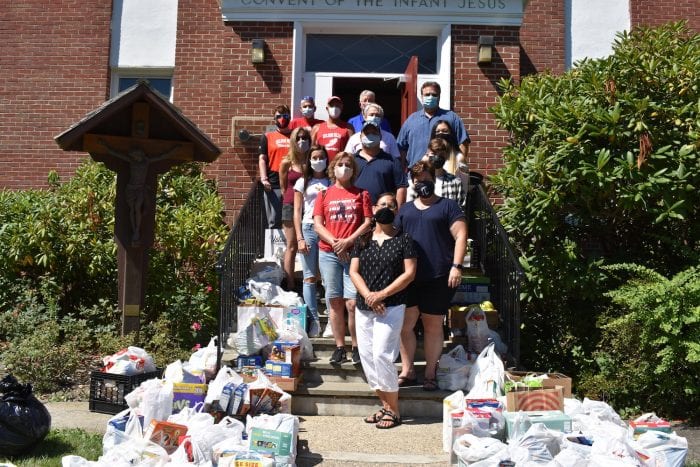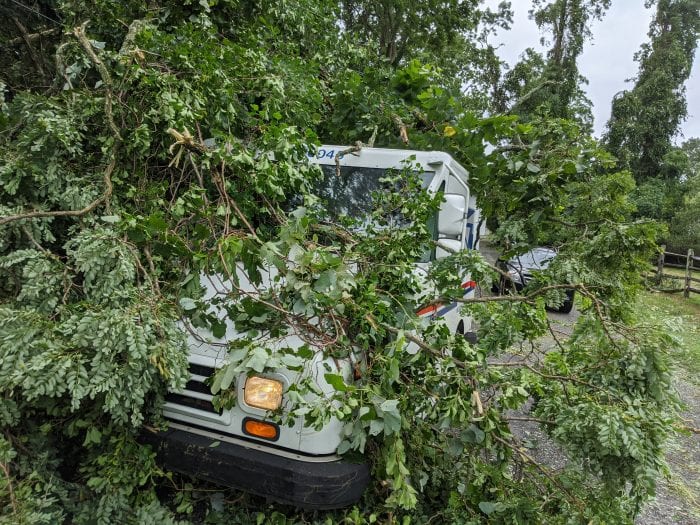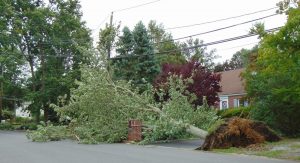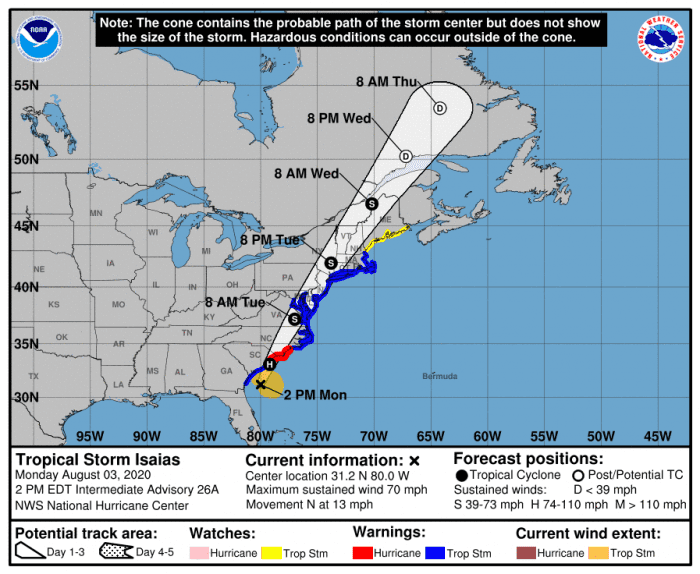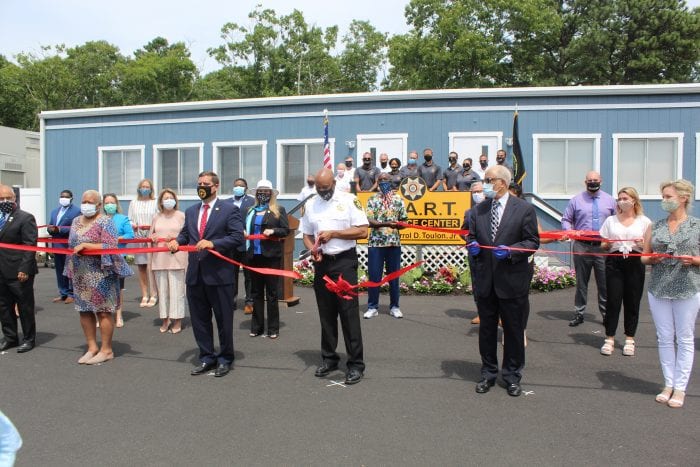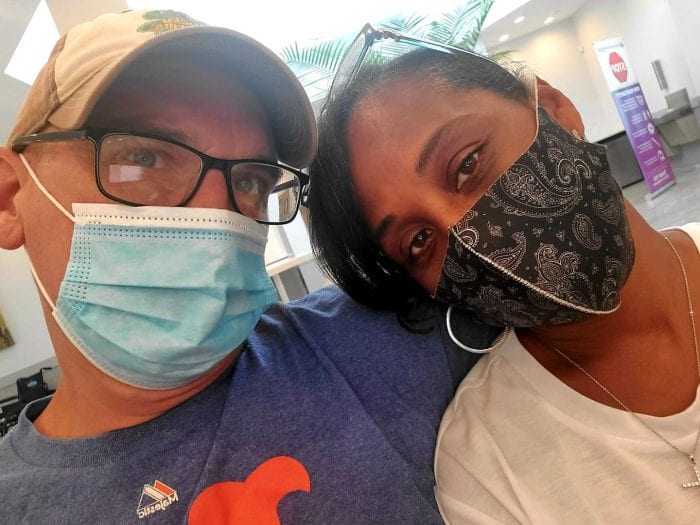By Kyle Barr and Liam Cooper
In front of what was the old nuns’ quarters of the Infant Jesus R.C. Church in Port Jefferson, the volunteers of the church’s food pantry stand amongst bag after bag of food items. Inside, even more goods line the main hallway, all before they can be taken in and sorted.
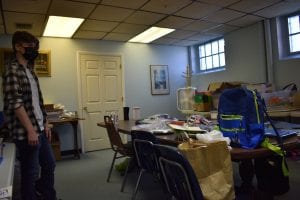
In just a few hours on a Monday morning, a crowd of regular volunteers have brought in the new hoard. Even after they leave, several more local residents swing by the front door of the Open Cupboard food pantry, dropping off clothing items, food, toiletries — a machine of giving.
All of it will be needed, according to food pantry leaders and volunteers, as by the end of the month so much of that food will be gone. The pandemic has led to a massive increase in food insecurity. Open Cupboard now regularly serves 30 to 60 families that come to its doors, and now they arrive every two weeks instead of every month, compared to what it was before the pandemic.
Though as the number of people needing assistance has increased during the pandemic, according to multiple local soup kitchens and food pantries, so has the number of volunteers hoping to make even the smallest difference.
Vicki Rybak, director of the Open Cupboard food pantry at Infant Jesus, has been on the job for the past 16 years. The pantry serves the surrounding area in Port Jeff, Port Jeff Station, Mount Sinai and parts of Coram and Setauket, and in her words, it serves “the working poor.”
“Now that the working poor aren’t working anymore, we’re servicing the people who aren’t getting anything — whether they’re undocumented and they’re not able to collect, or they’re essential like me and have been struggling,” she said.
During the worst months of the pandemic, the assembled group were Rybak’s “lifeline,” she said. People sent checks when she and others were limited on the number of certain foodstuffs and other essentials they could purchase.
People like Frank Davi, a retired NYPD officer who has been standing in front of the Miller Place Stop & Shop and Giunta’s Meat Farms in Port Jeff Station with his truck since March, asking people to donate food. He has given that food away to Open Cupboard and the pantry at St. Gerard Majella R.C. Church in Port Jefferson Station. He says he gets a truckload a week from people willing to help out.
“I was in Stony Brook [hospital] for six days, had some complications, came out of it fine and wanted to give back,” Davi said. “Everyone’s really generous in the community.”
The Open Cupboard is also in the midst of its back-to-school drive, and one of the downstairs rooms is piled with school supplies such as backpacks, pencils, erasers. It normally services around 185 children for back to school. Open Cupboard volunteer Jennifer Valentine, of Mount Sinai, said in a few weeks time, most of it will be gone.
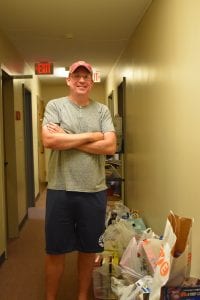
But the need will likely increase even more than that, as the pantry plans to work with local shelters as well to provide school supplies. Harder this year is so few schools have been posting what kinds of schools supplies students will need cover September.
“Even if we don’t go back to school, they will still need the supplies at home,”
Valentine said.
The pantry does much more than just food donations. It helps people apply for mortgage and rental assistance, helps people muddle through social services applications, assists people whose insurance doesn’t cover a particular procedure, all of which have seen a renewed need because of the economic impacts of the pandemic.
The Open Cupboard director has seen people with leases on nice cars pull up to seek aid, having lost their jobs and being on unemployment, having never before stepped foot into a food pantry in need of aid, whether it’s food or help getting their budgets in line.
“They’re lost, they’ve never done this before,” Rybak said. “People don’t even have the gas to come down here anymore — we’re doing a lot of deliveries.”
Now that a federal program that gave people an extra $600 on their unemployment checks has ended, she expects even more of a need. The hard part will be deciding what the organization is capable of doing, and what it can’t with the resources at hand.
“People are just really bad off, or they’re just barely making it with unemployment,” Rybak said.
Needy Numbers Likely on the Rise
According to Newsday’s latest nextLI survey about the impact of coronavirus, of the 1,043 respondents, close to a third said their financial situation has been negatively impacted due to the pandemic.
Things could get worse for the thousands still on unemployment. New York State statistics show Suffolk County had a 12.9 percent unemployment rate in June. Data for July is not yet available.

Paule Pachter, CEO of nonprofit Long Island Cares, said LIC has seen about 75,000 people coming for the very first time to the its distribution centers looking for emergency food since March 13. Most came after losing their jobs.
In normal times, the food bank operates six stationary and several mobile distribution centers. During the worst of the pandemic, the nonprofit saw the closure of close to one fifth of pantries it distributed to. Things have gotten better, and now they see only 31 closed. The rate of people LIC has seen seeking help has also dropped some small degree.
Still, Pachter has a strong suspicion that with the loss of benefits such as the unemployment funding will lead to a new wave of people seeking aid. He estimates another 50,000 will come in for food in the long run.
“The fact that people are laid off, furloughed, permanently terminated from their jobs and these are people who historically are living paycheck to paycheck … the whole unemployment scenario has been driving people to the food pantries or food distribution centers,” Pachter said. “If we don’t pass another stimulus bill or another extension on unemployment, that’s going to drive even more people to seek aid.”
Though as of the start of August, the federal program that put an extra $600 on top of people’s unemployment checks ended. Congressional leaders from the Democratic-controlled House and GOP-led Senate are locked in a debate over reinstating that relief, along with billions upon billions of dollars in other potential aid to people, businesses and local governments. The Senate is scheduled to take a recess, but it is unknown whether congressional leaders will leave such aid hanging. Republicans have balked at the idea of additional money on top of unemployment checks, saying it disincentivizes people to get back to work.
In the meantime, local pantries and soup kitchens expect the loss of those extra funds on unemployment checks could mean even more people needing assistance.
Lori Presser, the director of Trinity Friends Kitchen, a soup kitchen that operates out of the Trinity Evangelical Lutheran Church in Rocky Point, said she has no doubt it will get more people coming in within the coming weeks. While the kitchen before the pandemic was serving the same recognizable faces every Thursday, a host of new people showed up at its doors every week to pick up a hot meal, some hearing it from the church’s food pantry that’s now open every Tuesday, Thursday and Saturday. Before the pandemic, the kitchen was serving 250 meals per month, but now she estimates it serves about 350 per month.
“The $600 really helped keep everybody in a good position, but without that you will see many more people looking to stretch whatever available funds they have,” Presser said.
While the soup kitchen head said it is currently up to the task with current volunteers, she also worried about having to potentially bring more people into the kitchen should numbers pick up once again.
The Middle Island-based Island Heart Food Pantry, which hosts its food donations at the Mount Sinai Congregational Church on North Country Road, has felt the devastation of the pandemic. “It’s been the perfect storm,” director Kathy Lahey said.
The food pantry has experienced visibly longer lines since March, which is exacerbated by a decrease in volunteer staff.

“There is at least a 25 percent increase in customers,” Lahey said. “In a month we’ve fed about 500 to 600 families.”
On an average Wednesday before the pandemic, the food pantry would feed around 35 families. Now, it feeds 62. Lahey expects these numbers to continue increasing. The pandemic has caused many more families to be in need of the pantry’s services.
On top of its longer lines, Island Heart has also been trying to give more food to each family as well. With many kids doing online classes during this time, more families who depended on school food programs now need more food in the house during the day.
“Because kids were home from school, we also tried to give more food,” Lahey said.
Although the lines are getting longer, the volunteer staff is decreasing. Many of Island Heart’s volunteers remain skeptical about coming in, considering that, although they wear masks, remaining socially distant at the food pantry is difficult. Numbers are down to a skeleton crew of just three a day.
Between more patrons and less volunteers to work with, Island Heart was unsure if it was going to keep open.
“We’re taking it day by day,” Lahey said.
People Are Helping However They Can
What has surprised Rybak and others is just how much people have been willing to give, even while they too have been impacted by the global pandemic. While the Open Cupboard pantry normally has over 60 volunteers, even more people have put themselves out there to help since the start of the pandemic, a contrast with some of the difficulties Island Heart is dealing with.
“This is a 6,000 family parish, the volunteers really represent the heart of the parish, but we’ve noticed how more people have taken an interest since the pandemic,” said the Rev. Patrick Riegger, pastor at Infant Jesus.

Brian Hoerger, a trustee on the board of Theatre Three, and Doug Quattrock, a longtime actor with the company, have helped host two huge food collection drives with the theater in June and July, filling several carloads and the theater’s van “floor to ceiling” with items which they donated to Open Cupboard, enough to completely line the pantry’s main hallway, The theatre is now working on its third such drive for August.
“Now I come home and I find bags by my door, people just dropping stuff off,” Hoerger said.
Quattrock said he knows many of the people donating are still unemployed, yet they are still looking for ways to give back, “doing what they can,” he said.
Port Jefferson Rotary Club has also lent a hand in a big way the past few months, having been a regular supporter of the pantry for years. In addition to their Stuff-a-Van food collection events four times a year, fall food collection and their backpack packing event for back to school, Rotarians are also expected to bring in a specific product once a month.
The Selden Hills Warriors, an online group of runners based on Facebook, have also started hosting drives for eight pantries all over Long Island. There are currently four separate teams among the several hundred members buying food with a budget of about $100 each team per week.
“We’re just trying to keep it going, especially through the summer,” group leader Lou LaFleur said. “We have a generous group, and we want to do what we can because we saw the need.”
Despite its hardships, the Island Heart director said the pantry has experienced an increase in donations, both food and monetary. Many churchgoers at Mount Sinai Congregational have even been donating fresh produce from their own gardens, just so the food pantry can remain open.
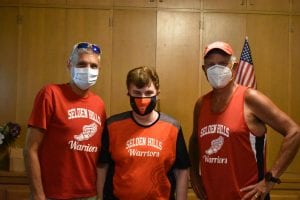
“We’ve seen so many donations from people even outside of our church,” Lahey said. “People just want to help.”
Food pantries and soup kitchens are relying on each other to keep open during these difficult times. Island Heart has gotten a lot of its food items from stores and food banks.
“Trader Joe’s, Long Island Cares and Island Harvest have been extremely helpful,” Lahey said. “We keep having to order more and more food.”
And as more needy people are potentially on the way, keeping those donations coming in could be make or break for a lot of shelters.
“We’re seeing a lot of new families coming in,” Open Cupboard’s Rybak said. “We had people who used to come to us, they were documented and they’re getting $600 a week, they’re buying us food. They’re giving back, so we know we’re doing the right thing, but the people who come in to us, they’re really getting hammered.”

